Marginal Product and Average Product
VerifiedAdded on 2022/08/09
|9
|931
|18
AI Summary
The File attached to this message has got detailed instructions on how the assignment is expected to be done. Please read carefully before starting the assignment.
Contribute Materials
Your contribution can guide someone’s learning journey. Share your
documents today.
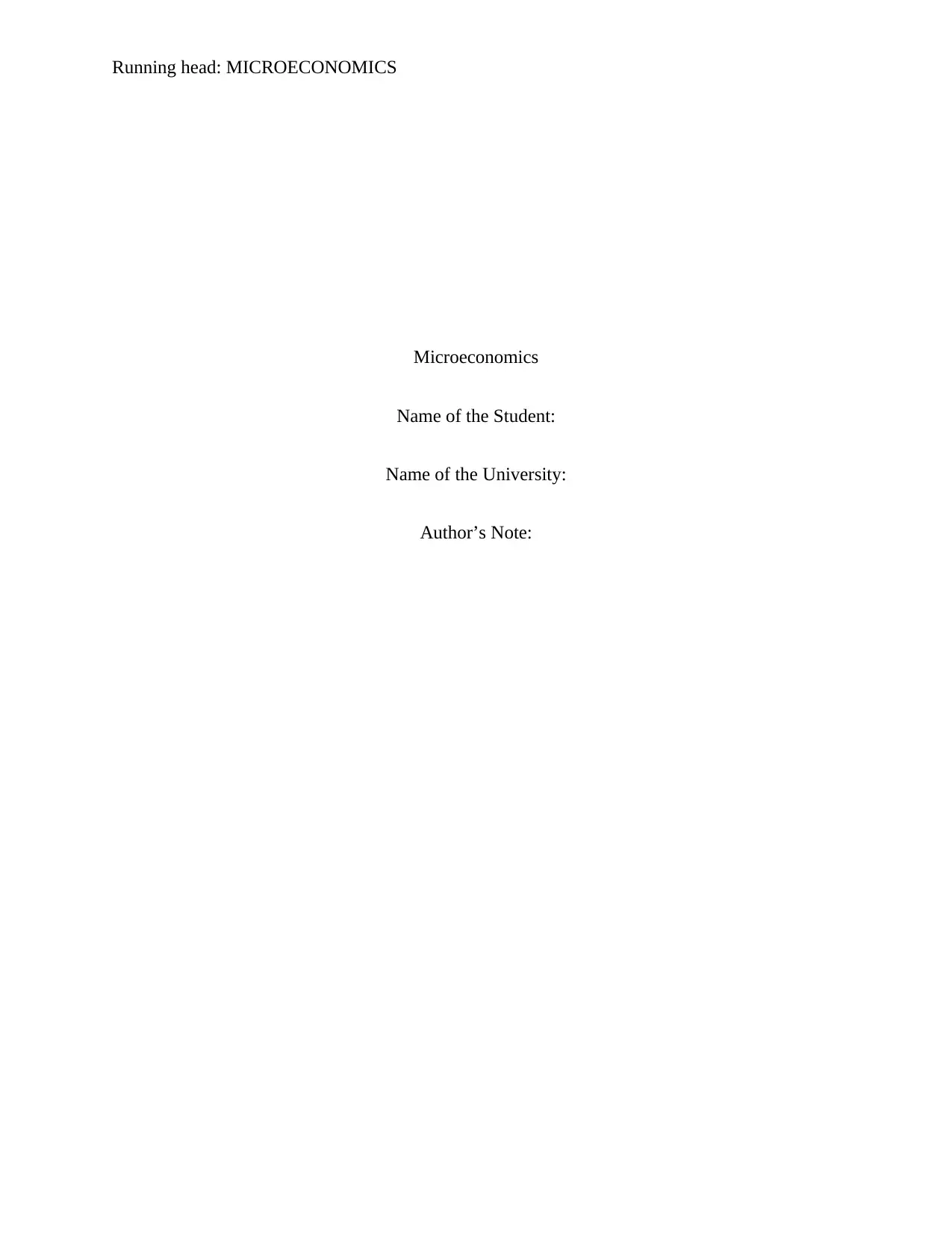
Running head: MICROECONOMICS
Microeconomics
Name of the Student:
Name of the University:
Author’s Note:
Microeconomics
Name of the Student:
Name of the University:
Author’s Note:
Secure Best Marks with AI Grader
Need help grading? Try our AI Grader for instant feedback on your assignments.
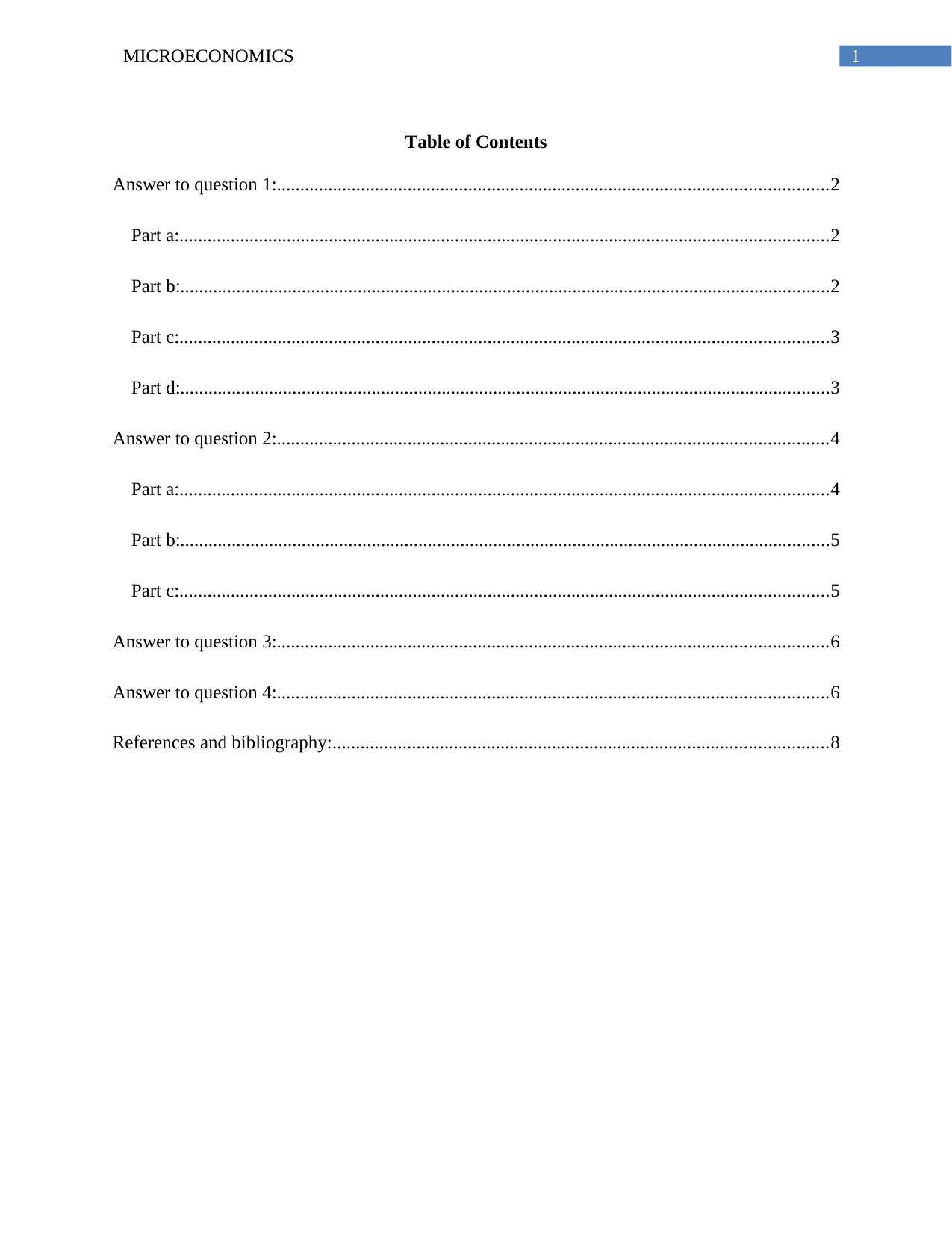
1MICROECONOMICS
Table of Contents
Answer to question 1:......................................................................................................................2
Part a:...........................................................................................................................................2
Part b:...........................................................................................................................................2
Part c:...........................................................................................................................................3
Part d:...........................................................................................................................................3
Answer to question 2:......................................................................................................................4
Part a:...........................................................................................................................................4
Part b:...........................................................................................................................................5
Part c:...........................................................................................................................................5
Answer to question 3:......................................................................................................................6
Answer to question 4:......................................................................................................................6
References and bibliography:..........................................................................................................8
Table of Contents
Answer to question 1:......................................................................................................................2
Part a:...........................................................................................................................................2
Part b:...........................................................................................................................................2
Part c:...........................................................................................................................................3
Part d:...........................................................................................................................................3
Answer to question 2:......................................................................................................................4
Part a:...........................................................................................................................................4
Part b:...........................................................................................................................................5
Part c:...........................................................................................................................................5
Answer to question 3:......................................................................................................................6
Answer to question 4:......................................................................................................................6
References and bibliography:..........................................................................................................8
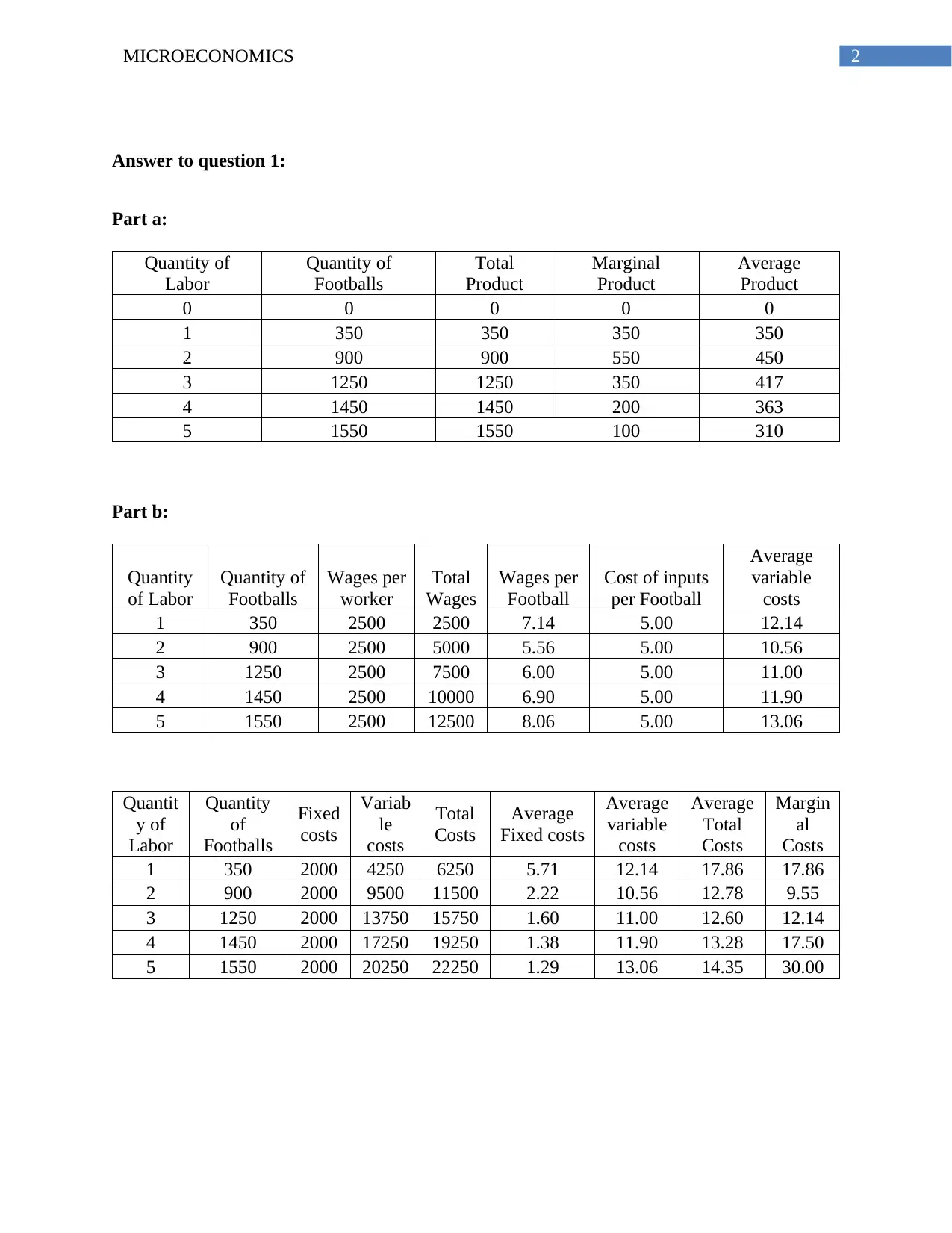
2MICROECONOMICS
Answer to question 1:
Part a:
Quantity of
Labor
Quantity of
Footballs
Total
Product
Marginal
Product
Average
Product
0 0 0 0 0
1 350 350 350 350
2 900 900 550 450
3 1250 1250 350 417
4 1450 1450 200 363
5 1550 1550 100 310
Part b:
Quantity
of Labor
Quantity of
Footballs
Wages per
worker
Total
Wages
Wages per
Football
Cost of inputs
per Football
Average
variable
costs
1 350 2500 2500 7.14 5.00 12.14
2 900 2500 5000 5.56 5.00 10.56
3 1250 2500 7500 6.00 5.00 11.00
4 1450 2500 10000 6.90 5.00 11.90
5 1550 2500 12500 8.06 5.00 13.06
Quantit
y of
Labor
Quantity
of
Footballs
Fixed
costs
Variab
le
costs
Total
Costs
Average
Fixed costs
Average
variable
costs
Average
Total
Costs
Margin
al
Costs
1 350 2000 4250 6250 5.71 12.14 17.86 17.86
2 900 2000 9500 11500 2.22 10.56 12.78 9.55
3 1250 2000 13750 15750 1.60 11.00 12.60 12.14
4 1450 2000 17250 19250 1.38 11.90 13.28 17.50
5 1550 2000 20250 22250 1.29 13.06 14.35 30.00
Answer to question 1:
Part a:
Quantity of
Labor
Quantity of
Footballs
Total
Product
Marginal
Product
Average
Product
0 0 0 0 0
1 350 350 350 350
2 900 900 550 450
3 1250 1250 350 417
4 1450 1450 200 363
5 1550 1550 100 310
Part b:
Quantity
of Labor
Quantity of
Footballs
Wages per
worker
Total
Wages
Wages per
Football
Cost of inputs
per Football
Average
variable
costs
1 350 2500 2500 7.14 5.00 12.14
2 900 2500 5000 5.56 5.00 10.56
3 1250 2500 7500 6.00 5.00 11.00
4 1450 2500 10000 6.90 5.00 11.90
5 1550 2500 12500 8.06 5.00 13.06
Quantit
y of
Labor
Quantity
of
Footballs
Fixed
costs
Variab
le
costs
Total
Costs
Average
Fixed costs
Average
variable
costs
Average
Total
Costs
Margin
al
Costs
1 350 2000 4250 6250 5.71 12.14 17.86 17.86
2 900 2000 9500 11500 2.22 10.56 12.78 9.55
3 1250 2000 13750 15750 1.60 11.00 12.60 12.14
4 1450 2000 17250 19250 1.38 11.90 13.28 17.50
5 1550 2000 20250 22250 1.29 13.06 14.35 30.00
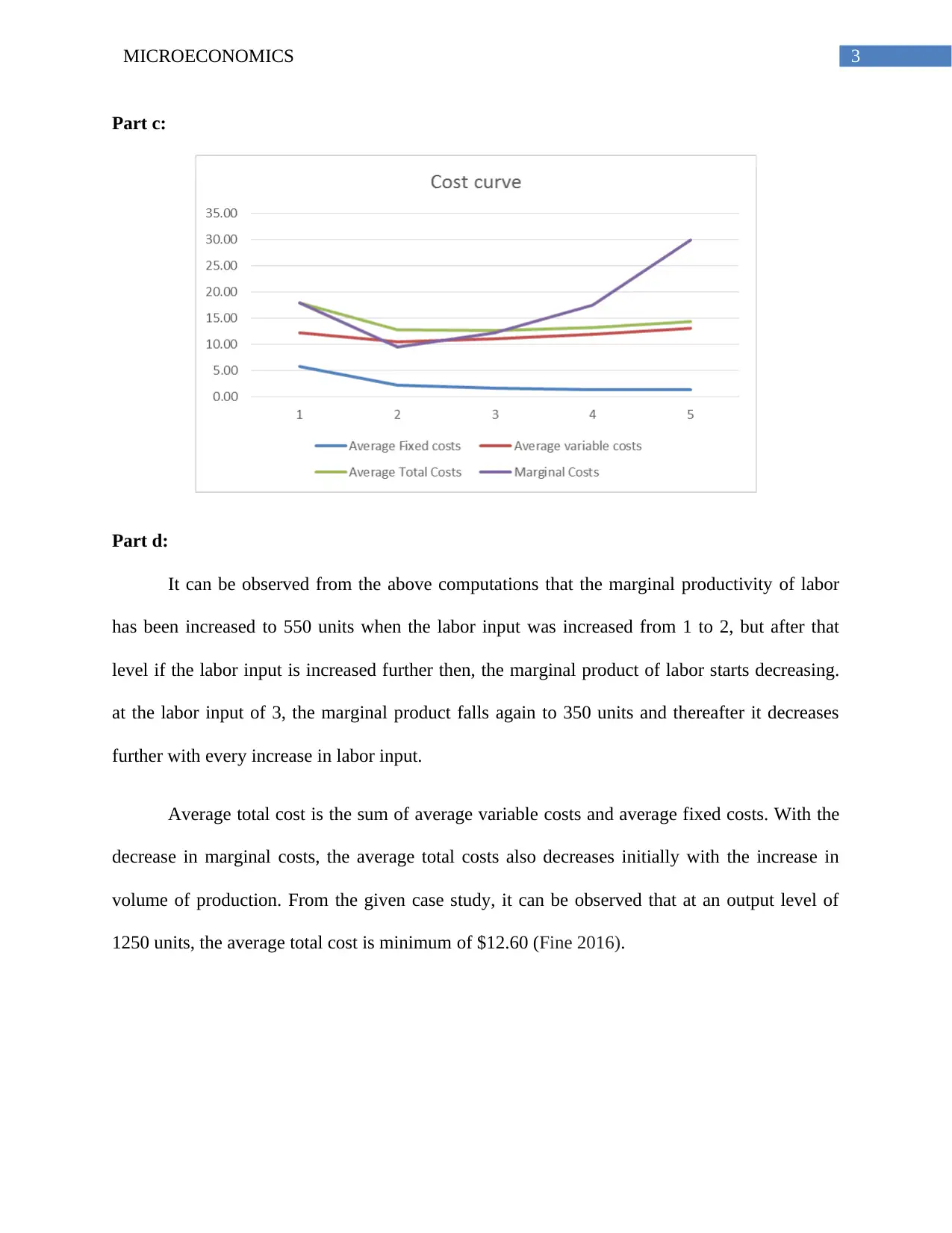
3MICROECONOMICS
Part c:
Part d:
It can be observed from the above computations that the marginal productivity of labor
has been increased to 550 units when the labor input was increased from 1 to 2, but after that
level if the labor input is increased further then, the marginal product of labor starts decreasing.
at the labor input of 3, the marginal product falls again to 350 units and thereafter it decreases
further with every increase in labor input.
Average total cost is the sum of average variable costs and average fixed costs. With the
decrease in marginal costs, the average total costs also decreases initially with the increase in
volume of production. From the given case study, it can be observed that at an output level of
1250 units, the average total cost is minimum of $12.60 (Fine 2016).
Part c:
Part d:
It can be observed from the above computations that the marginal productivity of labor
has been increased to 550 units when the labor input was increased from 1 to 2, but after that
level if the labor input is increased further then, the marginal product of labor starts decreasing.
at the labor input of 3, the marginal product falls again to 350 units and thereafter it decreases
further with every increase in labor input.
Average total cost is the sum of average variable costs and average fixed costs. With the
decrease in marginal costs, the average total costs also decreases initially with the increase in
volume of production. From the given case study, it can be observed that at an output level of
1250 units, the average total cost is minimum of $12.60 (Fine 2016).
Secure Best Marks with AI Grader
Need help grading? Try our AI Grader for instant feedback on your assignments.
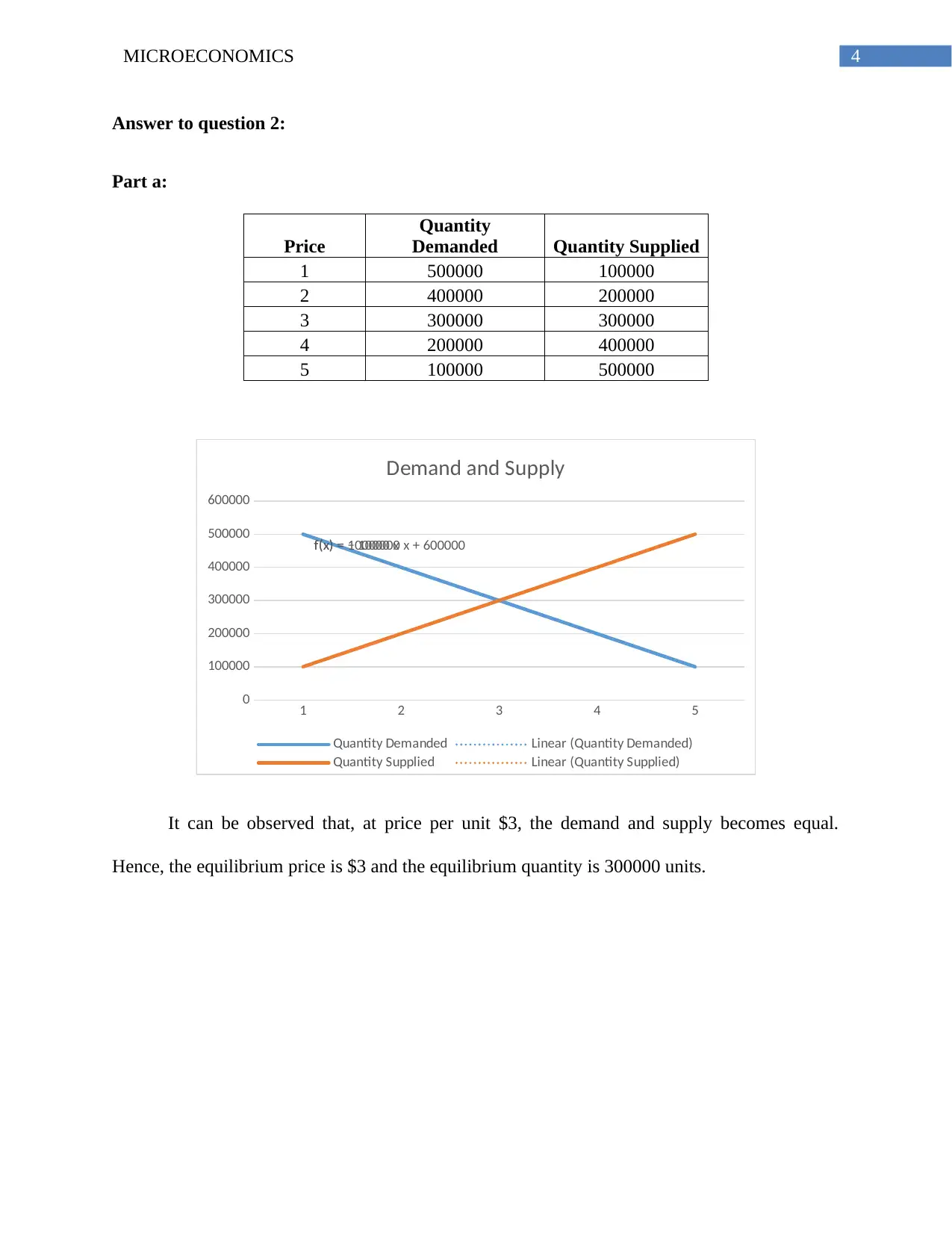
4MICROECONOMICS
Answer to question 2:
Part a:
Price
Quantity
Demanded Quantity Supplied
1 500000 100000
2 400000 200000
3 300000 300000
4 200000 400000
5 100000 500000
1 2 3 4 5
0
100000
200000
300000
400000
500000
600000
f(x) = − 100000 x + 600000f(x) = 100000 x
Demand and Supply
Quantity Demanded Linear (Quantity Demanded)
Quantity Supplied Linear (Quantity Supplied)
It can be observed that, at price per unit $3, the demand and supply becomes equal.
Hence, the equilibrium price is $3 and the equilibrium quantity is 300000 units.
Answer to question 2:
Part a:
Price
Quantity
Demanded Quantity Supplied
1 500000 100000
2 400000 200000
3 300000 300000
4 200000 400000
5 100000 500000
1 2 3 4 5
0
100000
200000
300000
400000
500000
600000
f(x) = − 100000 x + 600000f(x) = 100000 x
Demand and Supply
Quantity Demanded Linear (Quantity Demanded)
Quantity Supplied Linear (Quantity Supplied)
It can be observed that, at price per unit $3, the demand and supply becomes equal.
Hence, the equilibrium price is $3 and the equilibrium quantity is 300000 units.
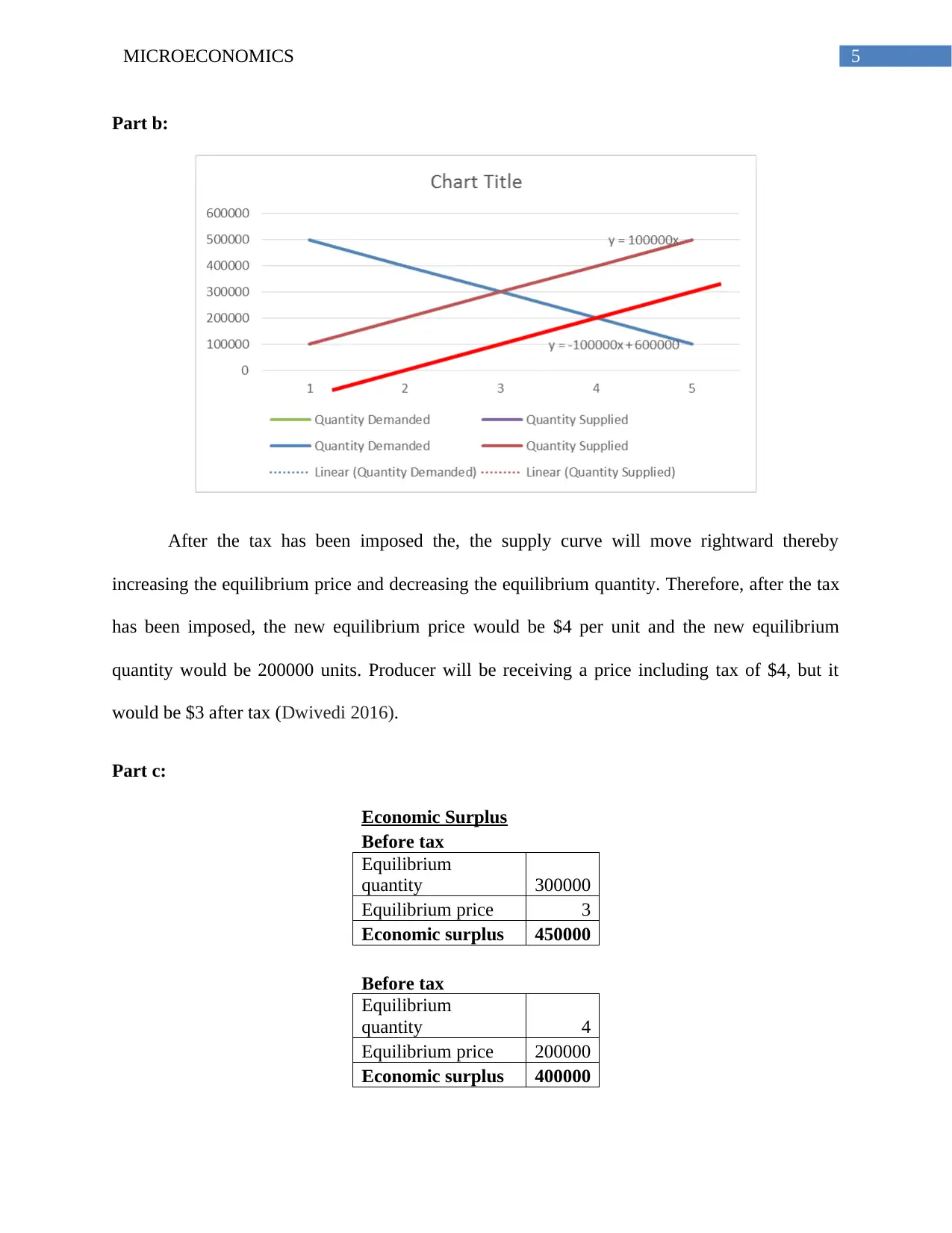
5MICROECONOMICS
Part b:
After the tax has been imposed the, the supply curve will move rightward thereby
increasing the equilibrium price and decreasing the equilibrium quantity. Therefore, after the tax
has been imposed, the new equilibrium price would be $4 per unit and the new equilibrium
quantity would be 200000 units. Producer will be receiving a price including tax of $4, but it
would be $3 after tax (Dwivedi 2016).
Part c:
Economic Surplus
Before tax
Equilibrium
quantity 300000
Equilibrium price 3
Economic surplus 450000
Before tax
Equilibrium
quantity 4
Equilibrium price 200000
Economic surplus 400000
Part b:
After the tax has been imposed the, the supply curve will move rightward thereby
increasing the equilibrium price and decreasing the equilibrium quantity. Therefore, after the tax
has been imposed, the new equilibrium price would be $4 per unit and the new equilibrium
quantity would be 200000 units. Producer will be receiving a price including tax of $4, but it
would be $3 after tax (Dwivedi 2016).
Part c:
Economic Surplus
Before tax
Equilibrium
quantity 300000
Equilibrium price 3
Economic surplus 450000
Before tax
Equilibrium
quantity 4
Equilibrium price 200000
Economic surplus 400000
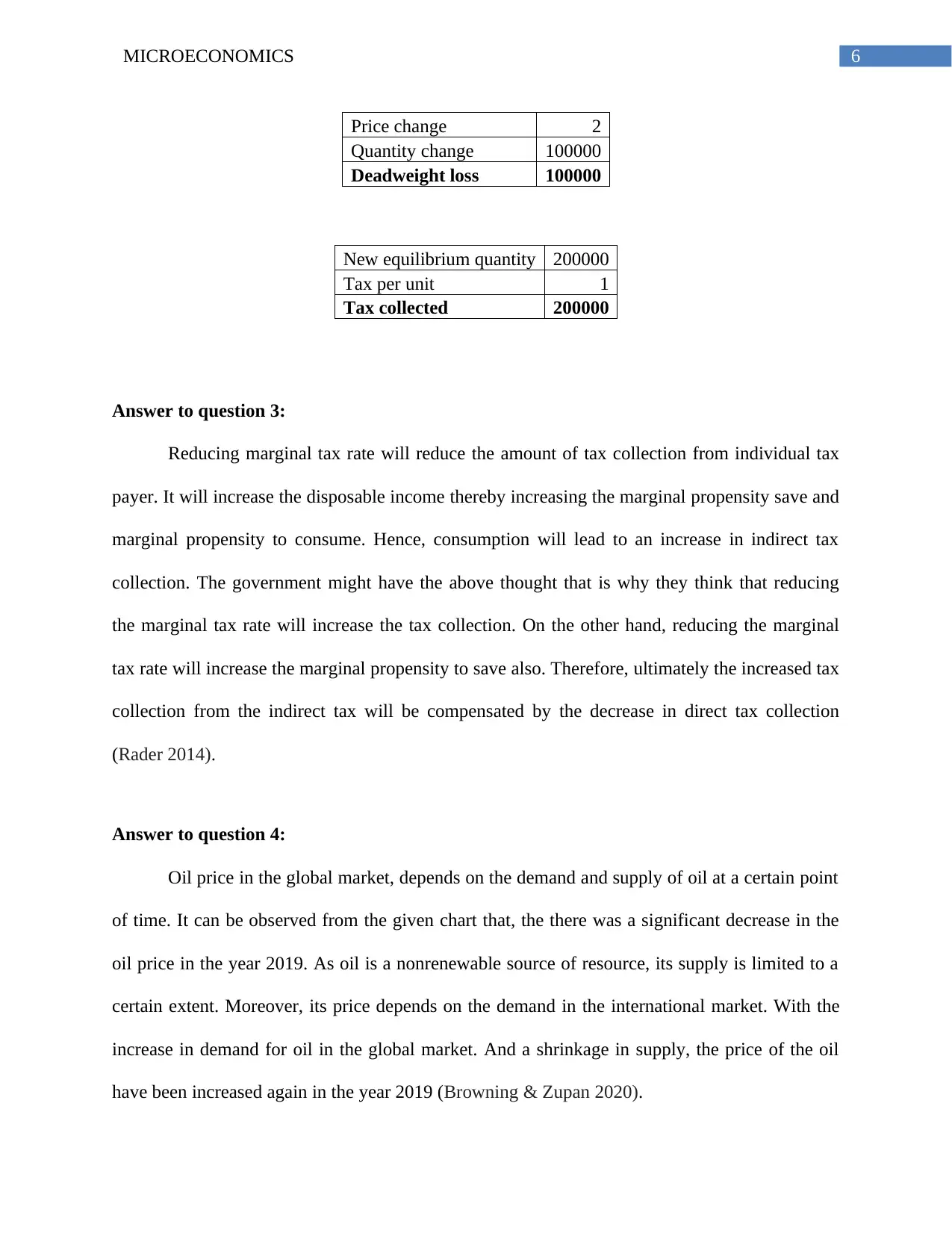
6MICROECONOMICS
Price change 2
Quantity change 100000
Deadweight loss 100000
New equilibrium quantity 200000
Tax per unit 1
Tax collected 200000
Answer to question 3:
Reducing marginal tax rate will reduce the amount of tax collection from individual tax
payer. It will increase the disposable income thereby increasing the marginal propensity save and
marginal propensity to consume. Hence, consumption will lead to an increase in indirect tax
collection. The government might have the above thought that is why they think that reducing
the marginal tax rate will increase the tax collection. On the other hand, reducing the marginal
tax rate will increase the marginal propensity to save also. Therefore, ultimately the increased tax
collection from the indirect tax will be compensated by the decrease in direct tax collection
(Rader 2014).
Answer to question 4:
Oil price in the global market, depends on the demand and supply of oil at a certain point
of time. It can be observed from the given chart that, the there was a significant decrease in the
oil price in the year 2019. As oil is a nonrenewable source of resource, its supply is limited to a
certain extent. Moreover, its price depends on the demand in the international market. With the
increase in demand for oil in the global market. And a shrinkage in supply, the price of the oil
have been increased again in the year 2019 (Browning & Zupan 2020).
Price change 2
Quantity change 100000
Deadweight loss 100000
New equilibrium quantity 200000
Tax per unit 1
Tax collected 200000
Answer to question 3:
Reducing marginal tax rate will reduce the amount of tax collection from individual tax
payer. It will increase the disposable income thereby increasing the marginal propensity save and
marginal propensity to consume. Hence, consumption will lead to an increase in indirect tax
collection. The government might have the above thought that is why they think that reducing
the marginal tax rate will increase the tax collection. On the other hand, reducing the marginal
tax rate will increase the marginal propensity to save also. Therefore, ultimately the increased tax
collection from the indirect tax will be compensated by the decrease in direct tax collection
(Rader 2014).
Answer to question 4:
Oil price in the global market, depends on the demand and supply of oil at a certain point
of time. It can be observed from the given chart that, the there was a significant decrease in the
oil price in the year 2019. As oil is a nonrenewable source of resource, its supply is limited to a
certain extent. Moreover, its price depends on the demand in the international market. With the
increase in demand for oil in the global market. And a shrinkage in supply, the price of the oil
have been increased again in the year 2019 (Browning & Zupan 2020).
Paraphrase This Document
Need a fresh take? Get an instant paraphrase of this document with our AI Paraphraser

7MICROECONOMICS
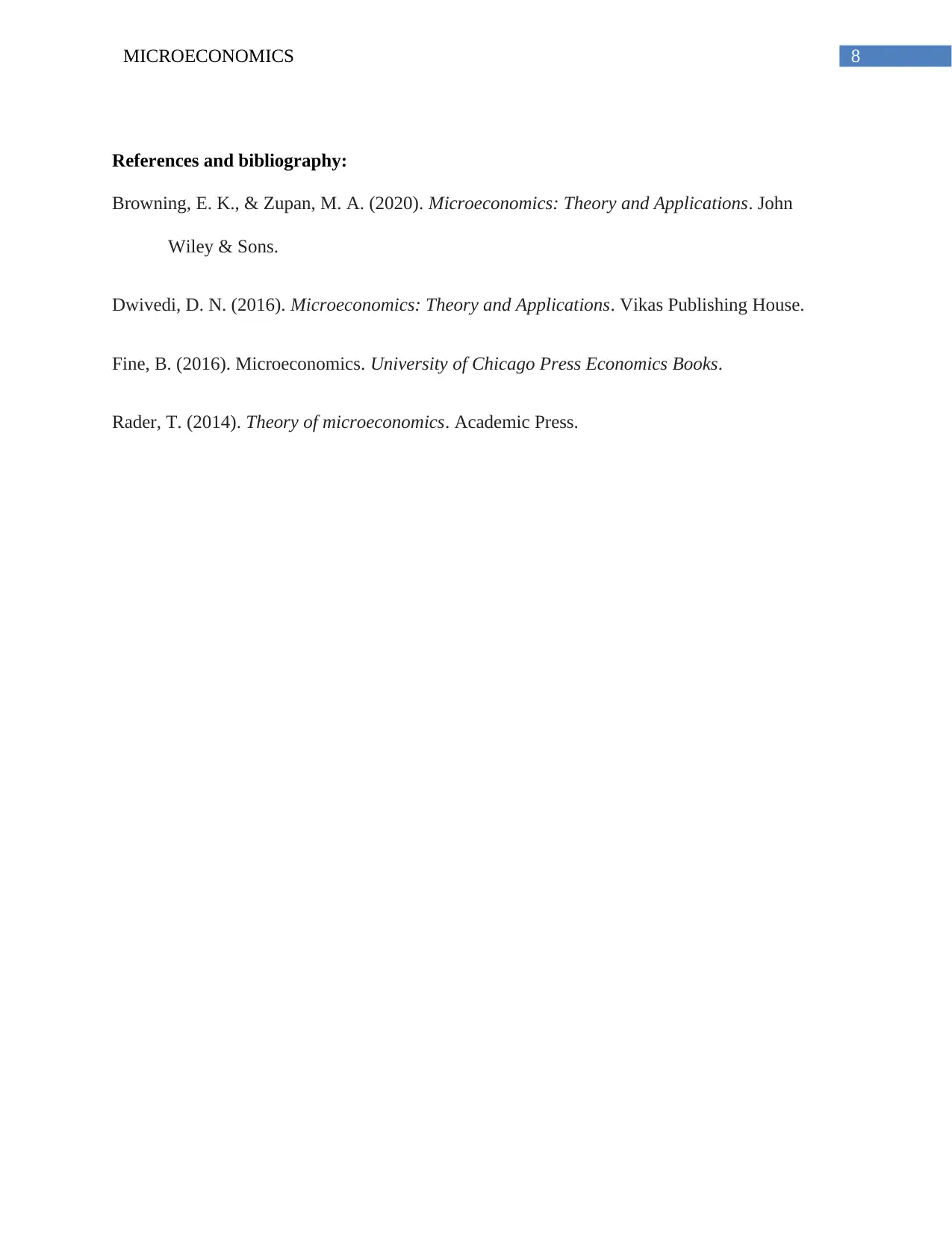
8MICROECONOMICS
References and bibliography:
Browning, E. K., & Zupan, M. A. (2020). Microeconomics: Theory and Applications. John
Wiley & Sons.
Dwivedi, D. N. (2016). Microeconomics: Theory and Applications. Vikas Publishing House.
Fine, B. (2016). Microeconomics. University of Chicago Press Economics Books.
Rader, T. (2014). Theory of microeconomics. Academic Press.
References and bibliography:
Browning, E. K., & Zupan, M. A. (2020). Microeconomics: Theory and Applications. John
Wiley & Sons.
Dwivedi, D. N. (2016). Microeconomics: Theory and Applications. Vikas Publishing House.
Fine, B. (2016). Microeconomics. University of Chicago Press Economics Books.
Rader, T. (2014). Theory of microeconomics. Academic Press.
1 out of 9
Your All-in-One AI-Powered Toolkit for Academic Success.
+13062052269
info@desklib.com
Available 24*7 on WhatsApp / Email
![[object Object]](/_next/static/media/star-bottom.7253800d.svg)
Unlock your academic potential
© 2024 | Zucol Services PVT LTD | All rights reserved.